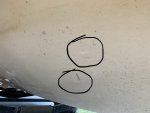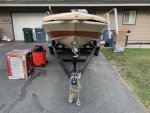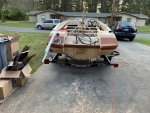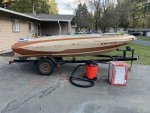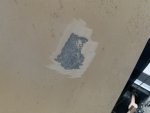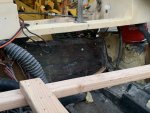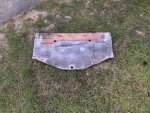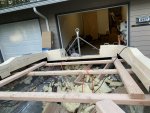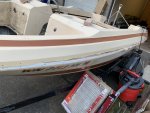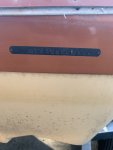das_army_life_yah
Petty Officer 2nd Class
- Joined
- Apr 3, 2020
- Messages
- 122
Archbuilder, here’s the blisters I was referring to earlier. I decided to get up under the beast today to get a really thorough look at it, and discovered a lot more blisters. There’s gotta be about 40-50 of them in total from bow to stern (maybe more, idk), all of them below the water-line........:mad-new:. Most of the blisters are 1/4” in diameter or smaller, with about 10 or so being about 3/4”. I checked the keel and strakes while I was down there and luckily there isn’t any signs of a hook to be found as far as I can tell.
I want this thing to last as long as possible because I have no intention of getting rid of it. I couldn’t imagine it being very feasible to grind out all the blisters and fill them in individually, especially since a good amount of osmosis has clearly set in and more blisters are bound to pop up if it’s not handled correctly. This brings me to my first MAJOR question so far in this build.....What should I do? I’ve listed a few options that I came up with. Change them or give me other options....I’d love to hear your opinions and ideas.
OPTION 1:
Sand everything down and give it a guide coat. Grind out all the blisters I can find and let them dry out for 4-6 weeks. Fill them in with resin/putty and glass. Sand the rest of the Gelcoat that wasn’t blistered and fix any imperfections and give it a few layers of rolled/tipped Gelcoat. If any more blisters started showing up, fix them as they appear.
OPTION 2:
Strip the entire lower-half of the boat (everything but the cap). If I go this route, I plan to take the whole thing down to glass. I’d let it sit for at least 4-6 weeks to “dry out” before I touched anything. I’d then give it a skim-coat or two of vinylester resin to seal the laminate and prevent/delay blistering in the future. From there, I’d give it 2-3 layers of Gelcoat with a dump gun to build it back up.
OPTION 3:
The only difference between this and option 2, is that I would be looking for a 2-part vinylester paint/coating to make the boat/finish a little more hydrophobic than Gelcoat. If I went this route, I’d plan to do the cap the same way as well, except I’d just sand/fix imperfections in the existing Gelcoat instead of taking it down to glass.
OPTION 4:
Given the design of the hull (see pics), remove all the Gelcoat from about 2” above the water-line and do something similar to what I mentioned in options 2 & 3.
I plan to bed/glass-in the stringers and transom before I attempt any of these options. I’m gonna hold off on the decking until I can finish the exterior, just in case I need to have access to the interior of the hull for repairs. I was REALLY hoping to have this thing seaworthy for this season, but it’s looking like it won’t see water until next year at the very soonest......:facepalm:
I want this thing to last as long as possible because I have no intention of getting rid of it. I couldn’t imagine it being very feasible to grind out all the blisters and fill them in individually, especially since a good amount of osmosis has clearly set in and more blisters are bound to pop up if it’s not handled correctly. This brings me to my first MAJOR question so far in this build.....What should I do? I’ve listed a few options that I came up with. Change them or give me other options....I’d love to hear your opinions and ideas.
OPTION 1:
Sand everything down and give it a guide coat. Grind out all the blisters I can find and let them dry out for 4-6 weeks. Fill them in with resin/putty and glass. Sand the rest of the Gelcoat that wasn’t blistered and fix any imperfections and give it a few layers of rolled/tipped Gelcoat. If any more blisters started showing up, fix them as they appear.
OPTION 2:
Strip the entire lower-half of the boat (everything but the cap). If I go this route, I plan to take the whole thing down to glass. I’d let it sit for at least 4-6 weeks to “dry out” before I touched anything. I’d then give it a skim-coat or two of vinylester resin to seal the laminate and prevent/delay blistering in the future. From there, I’d give it 2-3 layers of Gelcoat with a dump gun to build it back up.
OPTION 3:
The only difference between this and option 2, is that I would be looking for a 2-part vinylester paint/coating to make the boat/finish a little more hydrophobic than Gelcoat. If I went this route, I’d plan to do the cap the same way as well, except I’d just sand/fix imperfections in the existing Gelcoat instead of taking it down to glass.
OPTION 4:
Given the design of the hull (see pics), remove all the Gelcoat from about 2” above the water-line and do something similar to what I mentioned in options 2 & 3.
I plan to bed/glass-in the stringers and transom before I attempt any of these options. I’m gonna hold off on the decking until I can finish the exterior, just in case I need to have access to the interior of the hull for repairs. I was REALLY hoping to have this thing seaworthy for this season, but it’s looking like it won’t see water until next year at the very soonest......:facepalm:




















